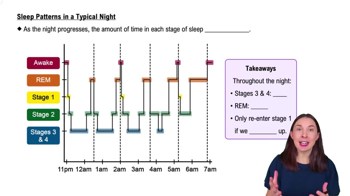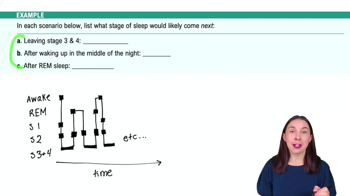Table of contents
- 1. Introduction to Psychology1h 43m
- 2. Psychology Research2h 20m
- 3. Biological Psychology2h 41m
- 4. Sensation and Perception28m
- 5. Consciousness and Sleep32m
- 6. Learning41m
- 7. Memory34m
- 8. Cognition37m
- 9. Emotion and Motivation35m
- 10. Developmental Psychology33m
- 11. Personality48m
- 12. Social Psychology41m
- 13. Stress and Health41m
- 14. Psychological Disorders44m
- 15. Treatment47m
5. Consciousness and Sleep
Sleep
Struggling with Psychology?
Join thousands of students who trust us to help them ace their exams!Watch the first videoMultiple Choice
James is a graduate student working in a sleep lab. He is analyzing EEGs, focusing on the height of the waves. Based on this information, what specific aspect of the EEGs is James studying?
A
Frequency
B
Amplitude
C
Wavelength
 Verified step by step guidance
Verified step by step guidance1
Understand that EEGs (electroencephalograms) are used to measure electrical activity in the brain, represented by wave patterns.
Recognize that the 'height of the waves' in an EEG refers to the vertical measurement from the peak to the trough of the wave.
Identify that this vertical measurement is known as 'amplitude,' which indicates the strength or intensity of the brain's electrical activity.
Differentiate between amplitude and other aspects of EEG waves, such as frequency (the number of waves per second) and wavelength (the distance between successive peaks).
Conclude that James is specifically studying the amplitude of the EEG waves, as it relates to the height of the waves he is analyzing.

 3:25m
3:25mWatch next
Master Circadian Rhythms with a bite sized video explanation from Hannah Gordils
Start learningRelated Videos
Related Practice


































































































![Race, Genes and IQ Differences | Bret Weinstein [Mini Clip]](https://img.youtube.com/vi/IztL_m3pd70/mqdefault.jpg)



































































































